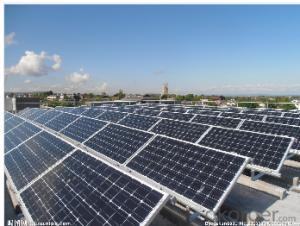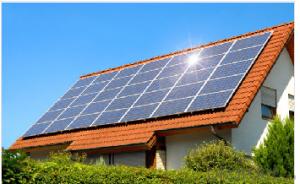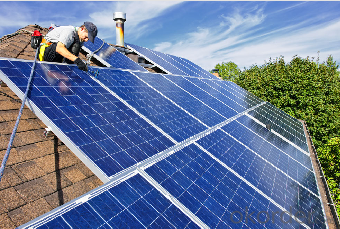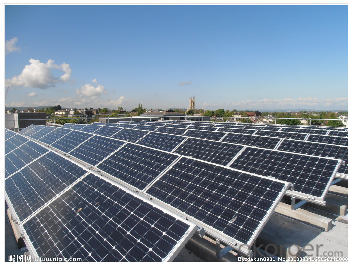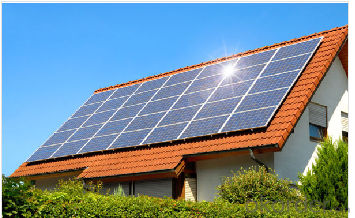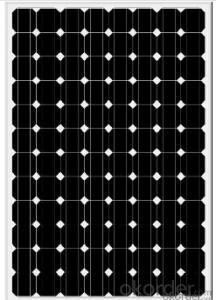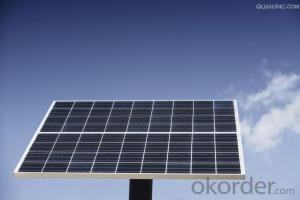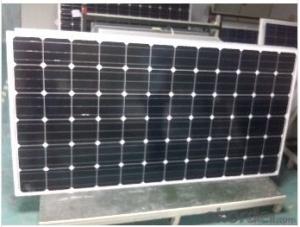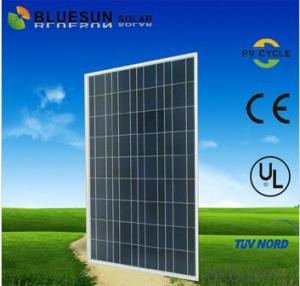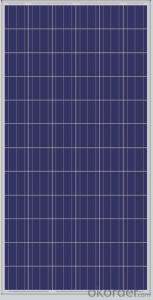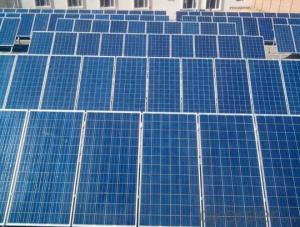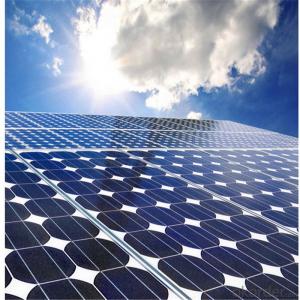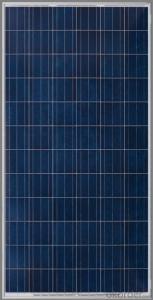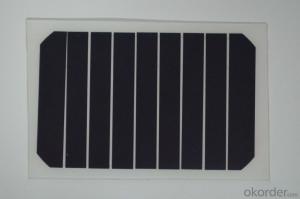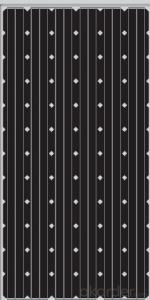Solar Panels 300 Watts from CNBM
- Loading Port:
- China main port
- Payment Terms:
- TT OR LC
- Min Order Qty:
- 1 pc
- Supply Capability:
- 10000000 pc/month
OKorder Service Pledge
OKorder Financial Service
You Might Also Like
Product Description:
Solar Module
ABOUT YINGLI GREEN ENERGY
Yingli Green Energy Holding Company Limited (NYSE: YGE) is one of
the world’s largest fully vertically integrated PV manufacturers, which
markets its products under the brand “Yingli Solar“. With over 7.0GW
of modules installed globally, we are a leading solar energy company
built upon proven product reliability and sustainable performance. We
are the fi rst renewable energy company and the fi rst Chinese company
to sponsor the FIFA World CupTM.
PERFORMANCE
- High effi ciency, multicrystalline silicon solar cells with high transmission
and textured glass deliver a module effi ciency of up to 16.0%,
minimizing installation costs and maximizing the kWh output of your
system per unit area.
- Tight positive power tolerance of 0W to +5W ensures you receive
modules at or above nameplate power and contributes to minimizing
module mismatch losses leading to improved system yield.
- Top ranking in the “TÜV Rheinland Energy Yield Test” and the
“PHOTON Test” demonstrates high performance and annual energy
production.
RELIABILITY
- Tests by independent laboratories prove that Yingli Solar modules:
Fully conform to certifi cation and regulatory standards.
Withstand wind loads of up to 2.4kPa and snow loads of up to
5.4kPa, confi rming mechanical stability.
Successfully endure ammonia and salt-mist exposure at the highest
severity level, ensuring their performance in adverse conditions.
- Manufacturing facility certifi ed by TÜV Rheinland to ISO 9001:2008,
ISO 14001:2004 and BS OHSAS 18001:2007.
WARRANTIES
- 10-year limited product warranty1.
- Limited power warranty1: 10 years at 91.2% of the minimal rated power
output, 25 years at 80.7% of the minimal rated power output.
1In compliance with our Warranty Terms and Conditions.
QUALIFICATIONS & CERTIFICATES
IEC 61215, IEC 61730, MCS, CE, ISO 9001:2008, ISO 14001:2004, BS OHSAS
18001:2007, PV Cycle, SA 8000
ELECTRICAL PERFORMANCE
Electrical parameters at Standard Test Conditions (STC)
Module type YLxxxP-29b (xxx=Pmax)
Power output Pmax W 260 255 250 245 240
Power output tolerances ΔPmax W 0 / + 5
Module effi ciency ηm % 16.0 15.7 15.4 15.1 14.8
Voltage at Pmax Vmpp V 30.3 30.0 29.8 29.6 29.3
Current at Pmax Impp A 8.59 8.49 8.39 8.28 8.18
Open-circuit voltage Voc V 37.7 37.7 37.6 37.5 37.5
Short-circuit current Isc A 9.09 9.01 8.92 8.83 8.75
Electrical parameters at Nominal Operating Cell Temperature (NOCT)
Power output Pmax W 189.7 186.0 182.4 178.7 175.1
Voltage at Pmax Vmpp V 27.6 27.4 27.2 27.0 26.8
Current at Pmax Impp A 6.87 6.79 6.71 6.62 6.54
Open-circuit voltage Voc V 34.8 34.8 34.7 34.6 34.6
Short-circuit current Isc A 7.35 7.28 7.21 7.14 7.07
STC: 1000W/m2 irradiance, 25°C cell temperature, AM1.5g spectrum according to EN 60904-3.
Average relative effi ciency reduction of 3.3% at 200W/m2 according to EN 60904-1.
NOCT: open-circuit module operation temperature at 800W/m2 irradiance, 20°C ambient temperature, 1m/s wind speed.
OPERATING CONDITIONS
Max. system voltage 1000VDC
Max. series fuse rating 15A
Limiting reverse current 15A
Operating temperature range -40°C to 85°C
Max. static load, front (e.g., snow) 5400Pa
Max. static load, back (e.g., wind) 2400Pa
Max. hailstone impact (diameter / velocity) 25mm / 23m/s
CONSTRUCTION MATERIALS
Front cover (material / thickness) low-iron tempered glass / 3.2mm
Cell (quantity / material / dimensions /
number of busbars)
60 / multicrystalline silicon / 156mm x 156mm / 2 or 3
Encapsulant (material) ethylene vinyl acetate (EVA)
Frame (material / color / anodization color /
edge sealing) anodized aluminum alloy / silver / clear / silicone or tape
Junction box (protection degree) ≥ IP65
Cable (length / cross-sectional area) 1000mm / 4mm2
Plug connector
(type / protection degree) MC4 / IP67 or YT08-1 / IP67 or Amphenol H4 / IP68
PACKAGING SPECIFICATIONS
Number of modules per pallet 29
Number of pallets per 40' container 28
Packaging box dimensions
(L / W / H) 1700mm / 1135mm / 1165mm
Box weight 568kg
Unit: mm
• Due to continuous innovation, research and product improvement, the specifi cations in this product information sheet are subject to change
without prior notice. The specifi cations may deviate slightly and are not guaranteed.
• The data do not refer to a single module and they are not part of the offer, they only serve for comparison to different module types
- Q: Ok so if i wanted to put a solar panel on my house and i live where it snows, will that be a problem? If the snow covers the solar panel will that be a problem? If so then do i have to climb on my roof and clear it off or what?
- Yes, snow will reduce the amount of energy the photovoltaics recieve and convert to electricity. Because the panels usually have a very flat glass surface, and because the slope for the panels is usually fairly high, snow will often slide off. Freezing rain, esp freezing rain changing to snow can make a covering that's difficult to get off. If you don't usually get freezing rain, and if you usually have nice sun after snow storms, your panels should be clear most of the time.
- Q: What are the financial benefits of installing solar panels?
- Installing solar panels can provide numerous financial benefits. Firstly, solar panels can significantly reduce or eliminate monthly electricity bills as they generate free and sustainable electricity from the sun. This can result in substantial long-term savings, especially in areas with high electricity rates. Moreover, solar panels often have a long lifespan, making them a worthwhile investment. Additionally, many governments and utility companies offer financial incentives such as tax credits, rebates, and net metering programs, further reducing the upfront cost and maximizing the financial return. Lastly, solar panels can increase the value of a property, making it more attractive to potential buyers and potentially yielding a higher resale value. Overall, by installing solar panels, individuals can save money, increase their property value, and contribute to a more sustainable future.
- Q: I am seriously thinking about installing PhotoVoltais Solar panels (that generate electricity) on my roof. Besides the usual (cost, ROI, etc.), I was researching for the maintenance of these panels. We have tall trees around the house and needles and leaves fall on our roof all the time... not to mention the dirt and grime that collects over time.Do these decrease the capacity of the panels? Do the panels require a regular maintenance?Thanks!
- I don't know if the guy is right about cells burning out if they are covered. You should look on the Internet for insolation tables for your area to see the effective hours of sunlight. Then guesstimate the percentage of time the panels will be shaded. Those trees may make the solar thing a poor idea. He is right about the trees reducing you efficiency. If a panel is shaded about 0 percent, its output drops to close to zero. My panels are five years old, and I have washed them twice. There as been no noticeable dropoff in output.
- Q: Solar panels are all divided into these squares, forming a grid like pattern. Is it possible to have a single piece of solar panel?
- They are in form of panels ....panel observe heat to generate electricity
- Q: Can solar panels be installed on a hospital or healthcare facility?
- Yes, solar panels can be installed on a hospital or healthcare facility. In fact, many healthcare facilities are increasingly adopting solar energy as a sustainable and cost-effective solution to meet their electricity needs. Solar panels can be installed on rooftops, parking lots, or open land adjacent to the facility, providing clean and renewable energy that can help reduce electricity costs and carbon emissions. Additionally, solar installations can contribute to the facility's green image and commitment to environmental sustainability.
- Q: Can solar panels be installed on a historical building?
- Yes, solar panels can be installed on a historical building. However, the installation process should be carefully planned and designed to minimize any potential impact on the building's historical integrity. It is important to consult with experts and adhere to any local regulations or preservation guidelines to ensure a harmonious integration of solar panels without compromising the building's historical value.
- Q: We have LED at the output of 40 watts and is used for 0 hours giving us 400 Watts-hr of energy consumed.Rechargable batteries needed are 2 V. 400/2 gives us 34 Ampere-hour battery needed. If we want it for 3 days, It would be 34x3=00 Ah. So the battery needed 00 AhNow how do I select the solar panel which can charge this/these batteries? What should be its rating?
- First, you need to make sure that your battery can take a regular 34Ah discharge without damage. The usual wisdom when using deep cycle lead-acid batteries is to allow for no greater than 50% discharge. This is to prevent the battery from ageing prematurely. Note that automotive batteries are not usually considered suitable for deep-cycle applications. Best allow for at least 200Ah capacity. Your solar panel capacity needs to take into account that whatever the nameplate output of the panel, that will be what it will produce under ideal conditions, actual output will always be less, often quite a bit less. You also need to allow capacity to cope with dull, overcast days when the light level is very low. You can get solar maps that will give you the sunshine hours and irradiation levels at your location. The solar panel capacity ends up being a juggling act between available funds/space and how critical it is that the light always works as desired. Let's say you had a 400W panel, which sounds quite generous. In the middle of winter, it may produce only 75W for 5 hours on a dull day, not quite enough to run the light for 0 hours. Would you expect several such days in a row? How many days could a 00Ah of battery capacity cover under these conditions?
- Q: How do solar panels affect roof aesthetics?
- Solar panels can have both positive and negative impacts on roof aesthetics. On one hand, solar panels can enhance the visual appeal of a roof by adding a modern and eco-friendly element. They can also create a sleek and streamlined look when installed properly. However, some people may find solar panels to be visually intrusive or out of place, especially if they do not blend well with the overall architectural design of the building. Ultimately, the impact on roof aesthetics depends on personal preferences and the design and placement of the solar panels.
- Q: thinking of getting a portable solar panel laptop charger...may be a stupid question but may be a very intelligent one as well ;)
- If you intend to use your panels inside a plane, answer is: solar panel intended for indoors use would most likely work inside a plane without problems. If you intend to mount your panel outside a plane :) it would actually work better than on the ground - there is more light at high altitudes and above clouds than it is on the ground. I'm not sure what portable in this case means - how big or how small is your panel? Solar panels are known for their low efficiency, so high-power solar panels are too big and too heavy to be used in aeroplanes.
- Q: a fiber optic network could distribute solar energy from warm states to the rest of the country. Using a Federally created program,the energy would be used through a trust program to benefit all of our citizens equally. It would create thousands of jobs and help us with our dependence on foriegn oil supplies. This is no different than work programs created by the Feds during the 930's depression era.
- Claire's argument doesn't make much sense to me either. First; Claire is talking about the second law ('you can only lose or break even'), not the third law ('you can't get to absolute zero'). Easily confused, but not that important! Putting a solar panel down _can_ increase the heat absorbed by Earth. Everything has an 'albedo' (the proportion of incoming light it reflects), and Earth's average albedo is about 0.3 (ie 30% of incoming light is reflected, most of which leaves the atmosphere straight away). By putting a 0.05 albedo solar panel down on a 0.3 albedo surface, you increase the amount of sunlight that is absorbed by Earth and therefore contribute to warming. This heat is re-radiated at the Earth's temperature, in the right wavelength range to be absorbed by greenhouse gases too. If you put a panel down on equatorial ocean, or a black roof, however, there is pretty much no effect (since the albedo change is small). Also, the heating effect only lasts as long as the panel is there. Most panels are estimated to last 50 years, meanwhile CO2 has a mean lifetime of 00+ years. I did some maths and found that the 00 year averaged change in radiative forcing for solar panels was negative compared to the UK electric grid, because the reduction in CO2 emissions has a larger effect than the change in albedo. If I have spare time tomorrow I'll redo the calculations and share them. The albedo change has to be considered though!
Send your message to us
Solar Panels 300 Watts from CNBM
- Loading Port:
- China main port
- Payment Terms:
- TT OR LC
- Min Order Qty:
- 1 pc
- Supply Capability:
- 10000000 pc/month
OKorder Service Pledge
OKorder Financial Service
Similar products
Hot products
Hot Searches
Related keywords

